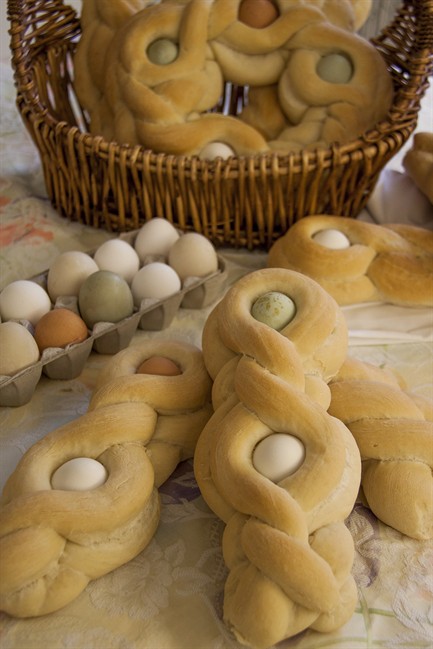Some Italian Easter breads are sweet, like a brioche or a pannetone in the shape of a dove. This recipe is for a plain bread, but it is the presentation that makes it special. The recipe can easily be halved.

- 5 ml (1 tsp) sugar
- 500 ml (2 cups) warm water
- 30 ml (2 tbsp) dry active yeast (2 packets)
- 1.5 kg (3 lb) bread flour (also called hard-wheat flour)
- 1.5 kg (3 lb) all-purpose flour
- 60 ml (4 tbsp) salt (kosher preferred)
- 1.25 l (5 cups) warm water
- 50 ml (1/4 cup) vegetable oil (optional)
- Whole washed raw eggs
In a measuring cup or bowl, mix sugar, warm water and yeast. Let sit and activate. It’s ready when surface is covered with bubbles.
Meanwhile, mix together flour and salt in a mixer bowl. Add activated yeast-water mixture and 1.25 l (5 cups) water and mix for 2 to 3 minutes. Add oil, if desired, to make dough smoother and allow dough to release easily from the side of the bowl. Knead dough until smooth and elastic.
Cover bowl with a towel or lid and let dough rise until it doubles in size. Place bowl in a draft-free area so it stays at room temperature. If you want to hurry your rising process along, put bowl in oven with door closed but heat off or fill a sink with a few centimetres (inches) of warm water and place bowl, covered by a towel, in water.
When dough has risen, punch down and remove from bowl onto a lightly floured wooden board. To make basic shape that weaves in 1 egg, cut off 2 pieces of dough about the same size (about 150-g/5-oz pieces). Roll pieces out into ropes about 2.5 cm (1 inch) thick using fingers and palms. While rolling, if you feel any large air bubbles in dough pierce them with a knife. If you find you have too much flour on your hands and board, which can make rolling difficult, lightly wet hands to get a better grip.

Get daily National news
Be sure eggs are washed and completely dry before putting together loaves. While working on each loaf, keep remaining dough covered with plastic wrap to keep it moist.
To make loaf, take first rope and loop dough in a U shape. Nestle egg, standing upright, in centre of loop, right in curve. Fold dough over itself, as if creating a braid, and making sure egg is tightly wound in dough. Create one or two more twists depending on length of dough ropes.
Roll second rope out slightly thinner, then lay it on top of first piece, creating a second U around egg. Again, fold dough over itself to create a twist and then a second twist. Pinch off ends and meld into bottom piece. You can use a dab of water to make 2 ropes stick together at ends or underneath twists.
Place on a baking sheet (the one you will use to bake them) to let them proof.
A similar shape can be created with 2 eggs. In this case, use 2 slightly larger pieces of dough to roll out into ropes. Make U shape with first rope and nestle first egg into curve. Twist rope twice, making sure egg is snug in dough. Place a second egg against second loop and make a third loop around it. Repeat with upper rope of dough.
To make a wreath shape, use even larger pieces of dough. Create a long twisted rope of dough with 4 or 5 eggs. Once base rope, with eggs, is complete, move it into a large circle and pinch ends together to complete that circle. A longer second rope can now be woven around the top of the wreath, twisting it between the eggs.
Let loaves rise, covered by towel, until almost doubled in size.
Heat oven to 200 C (400 F) and bake for 20 to 30 minutes, depending on oven, turning baking sheet at halfway mark, until bread is lightly golden and sounds hollow inside when tapped. The smaller one-egg twists will take closer to 20 minutes and the larger wreaths closer to 30. The eggs will also have baked.
Makes about 12 single twists or 3 full wreaths.
Source: Laura D’Amelio, http://www.anitaliancanadianlife.ca.






Comments